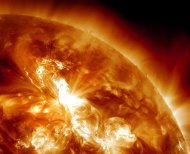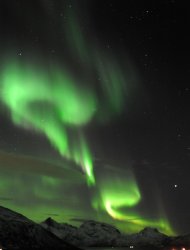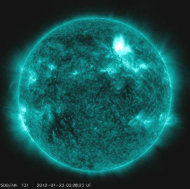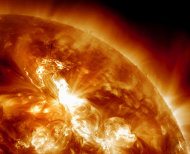My first memory at about One Year of age is of a view of the full moon through the window next to my crib. I remember standing up and holding onto the windowsill and marveling at the bright object in the sky. When I look at the sky, I feel absolutely ancient, like a Mayan or Babylonian astronomer. It still takes my breath away, and challenges me to believe in genetic/race memory.
Monday, January 30, 2012
Wednesday, January 25, 2012
Flights rerouted as massive solar storm slams Earth
From Yahoo News:
RELATED CONTENT
 Enlarge PhotoThis January 23, 2012 image provided by NASA, captured by the Solar Dynamics Observatory, …
Enlarge PhotoThis January 23, 2012 image provided by NASA, captured by the Solar Dynamics Observatory, … Enlarge PhotoAn Aurora borealis is pictured near the city of Tromsoe, northern Norway. Solar radiation …
Enlarge PhotoAn Aurora borealis is pictured near the city of Tromsoe, northern Norway. Solar radiation …
VIEW SLIDESHOWS
Protests return to Bahrain
14 photos - Tue, Jan 24, 2012Colombia's deadly drug ops
10 photos - 7 hrs agoFacebook mandates new timeline
6 photos - Thu, Jan 12, 2012
Solar radiation from a massive sun storm -- the largest in nearly a decade -- collided with the Earth's atmosphere, prompting an airline to reroute flights and skywatchers to seek out spectacular light displays.
US carrier Delta Air Lines said it had adjusted flight routes for transpolar journeys between Asia and the United States to avoid problems caused by the radiation storm, a spokesman said.
NASA confirmed the coronal mass ejection (CME) began colliding with Earth's magnetic field around 10:00 AM (1500 GMT) Tuesday, adding that the storm was now being considered the largest since October 2003.
Radiation storms are not harmful to humans, on Earth at least, according to the US space agency. They can, however, affect satellite operations and short wave radio.
The storm's radiation, likely to continue bombarding Earth's atmosphere through Wednesday, and its possible disruption to satellite communications in the polar regions prompted the flight rerouting, airline officials said.
Atlanta-based Delta, the world's second largest airline, said "a handful" of routes had their journey adjusted "based on potential impact" of the solar storm on communications equipment, spokesman Anthony Black told AFP.
Routes from Hong Kong, Shanghai and Seoul took a more southerly route after the solar flare erupted on Sunday.
The airline said it would continue to monitor solar activity before return flights to their normal routes.
Due to the unusual intensity of the photons raining on Earth, the spectacular aurora borealis -- the stunning "Northern Lights" display -- which is often seen closer to the Arctic pole at this time of year, has been seen as far south as Scotland and northern England, and at lower latitudes in the United States.
The event started late Sunday with a moderate-sized solar flare that erupted right near the center of the Sun, said Doug Biesecker, a physicist with the National Oceanic and Atmospheric Administration Space Weather Prediction Center.
"The flare itself was nothing spectacular, but it sent off a very fast coronal mass ejection traveling four million miles per hour (6.4 million kilometers per hour)," he told AFP.
Space weather watchers said the best aurora sightings are normally around midnight local time.
Rob Stammes, who runs the Lofoten Polar Light Centre in Lofoten, Norway said the CME's arrival Tuesday had produced a surge in ground currents outside his laboratory.
"This could be a happy day for many aurora watchers," he told aurora tracker website spaceweather.com
Solar storm buffets Earth: How protected is the US power grid?
From Yahoo News:
POLITICS SLIDESHOWS
First Lady Michelle Obama
20 photos - 11 hrs agoGabrielle Giffords resigns from Congress
25 photos - 11 hrs agoBest, worst and weirdest swag of the 2012 campaign
21 photos - 10 hrs ago
Power-grid operators nationwide are on high alert Tuesday as gale-force geomagnetic winds from a solar storm sweep across the Earth – creating potentially dangerous electrical currents that, if severe enough, could damage the US power grid.
The impact of this solar geomagnetic storm – called a “coronal mass ejection” by scientists – is being measured by satellites orbiting the Earth. It is the strongest such storm to hit Earth since 2005.
Still, it was expected to be moderate in intensity, compared with more severe events in the past, with only mild impacts on the power grid, solar storm experts said. Peak impact was expected Tuesday between morning and late in the day, solar weather experts said.
After the flare showed up on satellite sensors Sunday, solar storm advisories were sent by the National Oceanic and Atmospheric Administration to the nation’s independent system operators that oversee regional grid reliability in the nation 10 big power markets.
Solar flares and Northern lights
Beyond problems with satellites and radio communications, power generators and transmission line operators were advised to put the portions of the grid they control in a more defensive, robust posture. The idea is to gird for the impact of billions of tons of charged solar particles striking the Earth's magnetic field at two million miles per hour.
“We do not expect an impact to the bulk power system, however utilities are monitoring their facilities, as usual, for any abnormal energy flows and are prepared to take all appropriate actions to maintain reliability of the bulk power system,” writes Kimberly Mielcarek, spokesman for the North American Electric Reliability Corporation (NERC) in an e-mail. “We’re conferring with NOAA counterparts as needed, and sharing information with the North American bulk power system reliability coordinators.”
Intense debate has swirled over the issue of solar geomagnetic storms – and what, if anything, to do about these infrequent events beyond reactive, defensive actions. Most such storms have little impact on the Earth. Only a handful have had any serious impact over the past century. Still, the US and other modern societies are more dependent on power grids than ever – and damage to the grid could be severe in some cases.
The power grid is 10 times larger than it was in 1921, when the last solar super storm hit, effectively making it a giant new antenna for geomagnetic current. A far stronger solar outburst could overload and wreck hundreds of critical high-voltage transformers nationwide, blacking out 130 million people for months and costing as much as $2 trillion, according to a 2010 Oak Ridge National Laboratorystudy.
In 1859, the strongest geomagnetic storm on record made telegraph systems worldwide go haywire. So much induced current surged through the lines that some telegraph offices caught fire and wires melted. Most recently, a far-weaker 1989 solar storm knocked out power to millions of people in Quebec for about nine hours. Farther south, a large transformer at the Salem Nuclear Power plant in New Jersey was wrecked by the same event.
Should big transformers that would be most affected have surge protectors put on them to prevent them from burning out during a severe storm? How much would that cost? Should the federal government mandate such preparations?
Congress has repeatedly held hearings on the issue. In the previous session of Congress the House of Representatives overwhelming approved legislation that would have mandated that power-grid operators take action. But the Senate did not take up the matter – and new legislation is still sitting, waiting for passage.
For its part, NERC issued a 2010 report warning that geomagnetic storms, along with cyberattack and electromagnetic pulse attack with a nuclear weapon – were three high-impact but low-probability threats worth guarding against. Last May, NERC issued an advisory to regional power system operators identifying an array of steps available to them when NOAA issues warnings of a geomagnetic storm.
Practical actions that can be taken, for instance, include purchasing power from generators closer to where the power is being consumed rather than buying blocks of power that have to be sent on transmission lines that span several states, a move that enhances the stability of the grid by helping maintain necessary voltages on the system.
But debate over just how much damage would occur from such as storm is almost as intense as the storm itself. While experts are reported to largely agree that such storms could knock out big sections of the grid, there is sharp disagreement over how much damage it would do and whether big transformers would burn out and cause longer-term, wide-scale damage to the US economy, US experts say.
“We want to make sure that we aren't rash in our judgments,” says John Kappenman, the solar storm expert who conducted the seminal Oak Ridge National Laboratory study that warned of a worst-case scenario that could put 130 million people out of power for months or longer and cost more than $1 trillion.
To prevent such an unlikely but costly event, blocking devices, the equivalent of surge protectors for those big but possibly vulnerable transformers, could be installed at a cost of around $1 billion nationwide – a small cost when spread across households – and could be a saving grace, Mr. Kappenman says.
“Ultimately we have to figure out the right thing that needs to be done,” he says. “We absolutely have to get this right, because we can't wait for a big storm to learn all the things we need to learn. It's too large a consequence for society.”
Solar flares and Northern lights
Tuesday, January 24, 2012
Monday, January 23, 2012
Strongest solar storm since 2005 hitting Earth
from the AP and Yahoo News:
WASHINGTON (AP) — The sun is bombarding Earth with radiation from the biggest solar storm in more than six years with more to come from the fast-moving eruption.
The solar flare occurred at about 11 p.m. EST Sunday and will hit Earth with three different effects at three different times. The biggest issue is radiation, according to the National Oceanic and Atmospheric Administration's Space Weather Prediction Center in Colorado.
The radiation is mostly a concern for satellite disruptions and astronauts in space. It can cause communication problems for polar-traveling airplanes, said space weather center physicist Doug Biesecker.
Radiation from Sunday's flare arrived at Earth an hour later and will likely continue through Wednesday. Levels are considered strong but other storms have been more severe. There are two higher levels of radiation on NOAA's storm scale — severe and extreme — Biesecker said. Still, this storm is the strongest for radiation since May 2005.
The radiation — in the form of protons — came flying out of the sun at 93 million miles per hour.
"The whole volume of space between here and Jupiter is just filled with protons and you just don't get rid of them like that," Biesecker said. That's why the effects will stick around for a couple days.
NASA's flight surgeons and solar experts examined the solar flare's expected effects and decided that the six astronauts on the International Space Station do not have to do anything to protect themselves from the radiation, spokesman Rob Navias said.
A solar eruption is followed by a one-two-three punch, said Antti Pulkkinen, a physicist at NASA's Goddard Space Flight Center in Maryland and Catholic University.
First comes electromagnetic radiation, followed by radiation in the form of protons.
Then, finally the coronal mass ejection — that's the plasma from the sun itself — hits. Usually that travels at about 1 or 2 million miles per hour, but this storm is particularly speedy and is shooting out at 4 million miles per hour, Biesecker said.
It's the plasma that causes much of the noticeable problems on Earth, such as electrical grid outages. In 1989, a solar storm caused a massive blackout in Quebec. It can also pull the northern lights further south.
But this coronal mass ejection seems likely to be only moderate, with a chance for becoming strong, Biesecker said. The worst of the storm is likely to go north of Earth.
And unlike last October, when a freak solar storm caused auroras to be seen as far south as Alabama, the northern lights aren't likely to dip too far south this time, Biesecker said. Parts of New England, upstate New York, northern Michigan, Montana and the Pacific Northwest could see an aurora but not until Tuesday evening, he said.
For the past several years the sun had been quiet, almost too quiet. Part of that was the normal calm part of the sun's 11-year cycle of activity. Last year, scientists started to speculate that the sun was going into an unusually quiet cycle that seems to happen maybe once a century or so.
Now that super-quiet cycle doesn't seem as likely, Biesecker said.
Scientists watching the sun with a new NASA satellite launched in 2010 — during the sun's quiet period — are excited.
"We haven't had anything like this for a number of years," Pulkkinen said. "It's kind of special."
___
NOAA's Space Weather Prediction Center: http://www.swpc.noaa.gov/
NASA's Solar Dynamics Observatory: http://sdo.gsfc.nasa.gov/
.
Subscribe to:
Posts (Atom)











